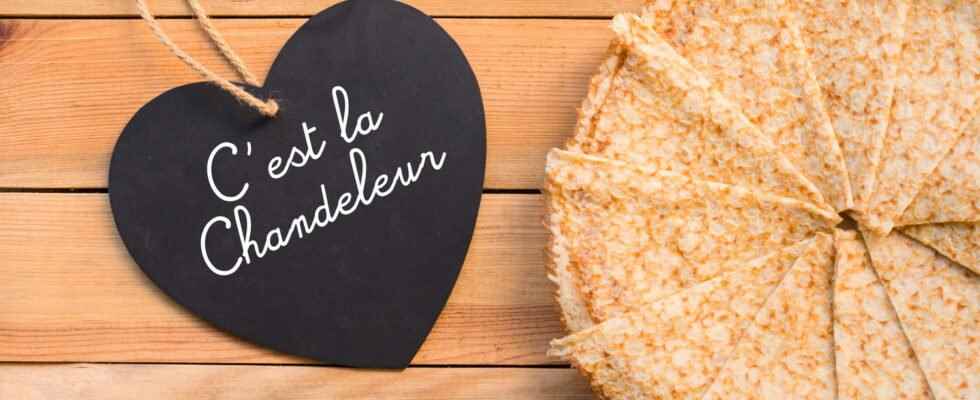[CHANDELEUR 2022]. This Wednesday, February 2, we’re blowing up pancakes on the occasion of Candlemas! Discover the origins of this festival and the reason why we eat pancakes, which are over 9000 years old!
What is Candlemas?
[Mise à jour du 2 février 2022 à 11h48]. Candlemas is above all a Christian holidayduring which we have become accustomed to eat pancakesin all its forms, savory or sweet, or even buckwheat pancakes, as a family.
What is the date of Candlemas?
This year, we celebrate Candlemas Wednesday, February 2, 2022. Next year, it will take place on Thursday, February 2, 2023. In the peasant world, February 2 also symbolizes the end of winter and the return to agricultural work. The blessed candles were therefore kept by the superstitious peasants who relit them in order to protect future harvests. Over time, the pancakes also became a token of allegiance of the farmers to their lords, who were offered them every year.
Pancake recipes for Candlemas
It is customary to eat pancakes on February 2, but some regions in the south of France celebrate Candlemas by tasting donuts. Discover the best pancake recipes to enjoy as a starter, main course or dessert:
What is the history of Candlemas?
Traditional Catholic feast, Candlemas originally celebrates the presentation of the child Jesus Christ in the Temple, precisely 40 days after his birth. It is in memory of this event that from 492 an annual procession was organized, during which blessed candles were lit.
What is the meaning of Candlemas for Christians?
The Candlemas festival takes its name from the Latin festa candelarum (candlelight festival).
Who invented pancakes?
Pancakes would have appeared 7000 years before Jesus Christ. At that time, they took the form of a relatively thick pancake, made with a dough combining water and crushed cereals. They were then cooked on a flat and hot stone or thanks to a plate placed in the fireplace. It was not until the 13th century that pancakes made their appearance in Brittany and began to be made with buckwheat brought back to France after the crusades in Asia. Qualified as a 100-day plant, buckwheat quickly flourished in this humid region, with a temperate climate and acidic soil. Pancakes were then called Krampouez in Breton. It is therefore the buckwheat pancake that was born first because the pancake made from wheat flour did not appear until the beginning of the 20th century.
Why do we make pancakes on Candlemas?
It was during one of these processions that the traditional pancake sharing was born every February 2. In order to encourage and reward the many pilgrims who came to Rome to celebrate Candlemas, Pope Gelasius I distributed pancakes (from crispuswavy in Latin), called “forgotten” at that time, thus giving rise to a tradition that is still respected.
As is the case for many festivals, there is an atmosphere of superstition around Candlemas that is still present today. Many are those who continue to flipping their first crepe with their right hand, a Louis d’or in their left hand. Still others threw this first pancake over the cupboard, always out of superstition…
Candlemas and savory pancakes: where does the buckwheat galette come from?
The appearance of the first pancakes is estimated at 7000 BC.. At the time, they were prepared from all kinds of cereals and entered into the basic food, in the same way as soups and porridges. Buckwheat, or buckwheatappeared in France in the twelfth century the return of the Crusaders, to whom we owe the importation of this plant from Asia. Because contrary to its name, buckwheat has nothing to do with wheat and belongs to polygonaceae such as sorrel or rhubarb, even if by its cultivation and its use it tends to be classified among cereals. If the Brittany is known to be the homeland of buckwheat pancakes, it is because the lands and the temperate climate of this country were perfectly suited to the cultivation of buckwheat. This plant is also nicknamed the 100-day plant, in reference to its cultivation which extends over three months from June to the end of August. Wheat being reserved for wealthy landowners, buckwheat, and in particular pancakes, served for a long time as bread in porridges and soups, which it made more substantial. It is only at the late 19th centuryand the democratization of wheat bread, that buckwheat has lost its influence in gastronomy.
Before wheat became accessible to everyone, there were two types of preparations made from buckwheat: the galette and the buckwheat pancake. The wafer as it is still eaten today was rather a specialty of Upper Brittany. It was garnished with meats, ham, sausages, cheese and fish. In contrast, buckwheat crepe, was much thinner and crispier. This particular texture, which made its filling difficult, will moreover justify its gradual abandonment in favor of simple pancakes.
If nowadays, some people add eggs, butter, even milk or wheat flour in order to obtain a more supple and colored pancake, the recipe for water, salt and of course buckwheat, has remained the same for nearly 1,000 years. Even before the widespread use of wheat, people were already eating sweet pancakes. These were made at buckwheat base to which eggs, sugar and spices such as cinnamon were added. Popular throughout France, crêpes, as we know them today, have only existed since a little over a century. They have different names depending on the region and whether they are thin, thick, crispy, soft, large or small. They are known, for example, as tantimoles in Champagne, worth in the Ardennes, fruit bats in the country of Anjou or crupets in Gascony.
